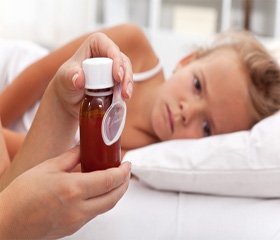Журнал "Гастроэнтерология" 1 (51) 2014
Вернуться к номеру
The molecular features of inflammation of the gastric mucosa of children with Helicobacter pylori infection associated with CagA (+) strains of H.pylori
Авторы: Abaturov O.Ye., Gerasymenko O.M. - State Establishment "Dnipropetrovsk Medical Academy of the Ministry of Health of Ukraine", Dnipropetrovsk
Рубрики: Гастроэнтерология
Разделы: Клинические исследования
Версия для печати
Introduction.Trans membrane signaling Toll-like receptor (TLR) plays key role in the activation of innate immune defense mechanisms in the invasion of pathogens, including, and Helicobacter pylori (H.pylori). Lipopolysaccharide (LPS) – the structural components of the outer membrane of gram-negative bacteria – one of the most important PAMP, are including H.pylori. The main TLR for LPS H.pylori is TLR4. PAMP TLR recognition occurs through direct interaction or by using accessories molecules – lipopolysaccharide binding protein (LBP), CD14, MD-2. Activation of a cascade of signaling molecules causes excitation of nuclear transcription factor kB (NF-kB) and the synthesis of pro-inflammatory cytokines.
Thus the main components of the innate immune response to infection H.pylori is an LBP, CD14, TLR4 and NF-κB.
Purpose. Evaluate the role of NF-κB and of factors of recognition innate immunity (TLR4, sCD14) in the development of inflammation of the gastric mucosa (GM) in children with chronic gastroduodenal diseases, depending on the presence of CagA (+) and CagA (–) strains of H.pylori.
Materials and methods. The study involved 66 children aged 7 to 17 years, patients with chronic gastroduodenal pathology in the acute stage. TLR4 gene expression level in the biopsy in real time was performed by polymerase chain reaction, the level of expression of NF-κB+ CD40+ cells was determined using monoclonal antibodies by flow cytometer (EPIX LX-MCL («Beckman Coulter», USA). The method ELISA was used to measure the concentration in serum sCD14 (test kit Diaclone, France). Identification of H.pylori-status was performed by rapid urease «Helpil» test and breath «Helik» test («AMA», Russia, St.-Petersburg), the definition of venous blood serum total immunoglobulin (IgM, IgA, IgG) to Ag CagA protein H.pylori by ELISA («Vector-Best», Russia).
Statistical analysis of the results was performed using the statistical software package PC «Statgraf», «Matstat», «Statistica 6.0». The reliability of the differences in the distribution other than the normal, estimated using the U-Mann-Whitney test, for data with normal distribution – t-Student's test. To compare the frequency characteristics between the studied groups using the criterion χ2 (Chi-square test) with the number of degrees of freedom equal to 1.
Results. We analyzed the expression of TLR4 in mucosal biopsy and nuclear factor NF-κB+ in lymphocytes, the concentration of TLR4-the accessory molecules in serum sCD14 levels in children with H.pylori infection depending on the presence of CagA (+) and CagA (–) strains of H.pylori. When comparing the concentration of sCD14 observed significant difference in the groups according to H.pylori-status. For example, patients infected with CagA (+) strains H.pylori, recorded higher concentrations sCD14, than children infected CagA (–) strains of H.pylori (Pu < 0,05).
Analysis of the results of molecular genetic studies indicate that children infected with CagA (+) strains of H.pylori, while maintaining the expressed clinical and endoscopic inflammatory changes in gastric mucosa, a decrease in the expression of TLR4 biopsy gastric mucosa and the level of expression of nuclear factor NF-kB+ in lymphocytes , in contrast to patients infected CagA (–) strains of H.pylori, and from the children, the disease which has not been associated with infection by H.pylori (Pu < 0,05). Our data indicate that patients with chronic CagA (+) HP-associated gastritis observed biased lower expression levels of the transcription factor NF-kB, which are accompanied by increased concentrations of sCD14. Such a combination of changes in the activity of molecular components LPS-associated proinflammatory cascade suggests that CagA (+) H.pylori strains are capable of inducing the inflammatory process around sCD14, which prevents the binding of LPS to CD14 membrane molecule and as a consequence, the excitation TLR4. However, drug modulation of sCD14 concentration may be one of the possible directions of treatment of Helicobacter pylori infection in children.
It is possible that inflammation of the gastric mucosa is supported by the activity of other proinflammatory transcription factors.
Conclusions.
1.The important molecular component, which determines the development of the activity of the inflammatory process in the gastric mucosal children, patients with chronic gastroduodenal diseases, is the transcription factor NF-kB.
2.In patients with active H.pylori infection, infected CagA (+) H.pylori strains, observed a significant increase in the concentration sCD14 in serum.
3.Children infected with CagA (+) strains of H.pylori, while maintaining expressed clinical and endoscopic inflammatory changes in the gastric mucosa observed decrease in activity TLR4 expression in biopsy of gastric mucosa in contrast to patients infected with CagA (–) strains of H.pylori, and children from diseases, which was not associated with H.pylori infection.

